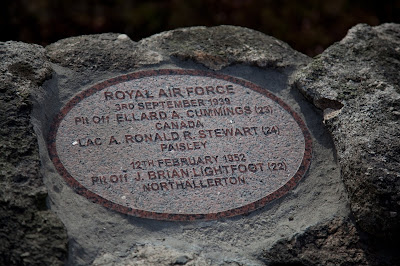The Man Who Fell to Earth
I went past the Bass
today, just to check if the Pictish Stones were back you understand. The sign
on the gate advised that they would indeed be back in place alongside the Mary
Eerie-Orie gravestone by late spring 2018 following much needed restoration and
digital scanning. It is now late summer and the twice buried Mary lies quite alone
in her grave.
I wrote about Mary in glowing terms in my A-Z of Curious Aberdeenshire book. The
unfortunate serial spouse was once buried alive after being mistakenly
pronounced dead following a short illness. The story is told in many versions.
In one, her distraught second husband rescues her when he hears her desperate cries
for help coming from the freshly filled grave.
In another version of the tale, the gravedigger spies a gold ring on the corpse’s finger. He tries and fails to remove it by hand and finally resorts to cutting off the unfortunate corpse’s finger with his knife at which point the ‘deceased’ wakes up howling in pain.
In another version of the tale, the gravedigger spies a gold ring on the corpse’s finger. He tries and fails to remove it by hand and finally resorts to cutting off the unfortunate corpse’s finger with his knife at which point the ‘deceased’ wakes up howling in pain.
Anyway, the trip was not without advantage. In the absence of
Pictish remains I set out on a graveyard tour to find the Commonwealth War
Graves. There are eleven listed on the CWGC website but, to my
surprise I encountered several more unlisted war dead amongst the family gravestones
scattered throughout the grounds. A Gordon Highlander who accidentally drowned in May 1918 in
the Pas-de-Calais is recalled alongside a lad from Balquhain lost at Beaumont
Hamel. Another, a Royal Army Medical Corps private died age 21 in 1915
somewhere in France.
An aviator took my fancy. The inscription on the Laing family
stone records that he was killed in combat over Arnaville on August 30 1918 age
just 20. A 2nd Lieutenant in the 55th Squadron of the
Royal Air Force, he is buried in a local churchyard near where he fell to earth.
A search reveals the following entry on the Next of Kin
Project site:
“Thomas Laing from
Inverurie, Aberdeenshire, joined the Royal Flying Corps as a bomber pilot. In
April 1918 he went to train at the Royal Air Force (RAF) station in Narborough,
Leicestershire, where he learnt how to fly his two-seat biplane day bomber. He
wrote to his parents every 4 to 5 days, describing the thrill of flying at high
altitudes and finally qualifying as a pilot. On 14 August 1918 Laing went on
his first flight behind enemy lines, bombing ground targets in Germany. 16 days
later he was shot down and killed, aged 21. After his death, Laing’s mother
received a letter from his girlfriend. It ends “I keep on remembering little
things he said and did. I just loved everything about him”.
Along with the official notification his mother was to receive his flying goggles, identity bracelet and service medals along with an official RAF photograph as a memento of her now dead son.
Along with the official notification his mother was to receive his flying goggles, identity bracelet and service medals along with an official RAF photograph as a memento of her now dead son.
There are a few signed copies of the first edition of The A-Z
of Curious Aberdeenshire available from Inverurie Whisky Shop and
more copies – unsigned of course – are
available via The History
Press and on Amazon.












Comments
Post a Comment